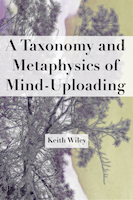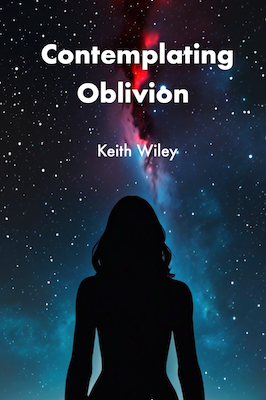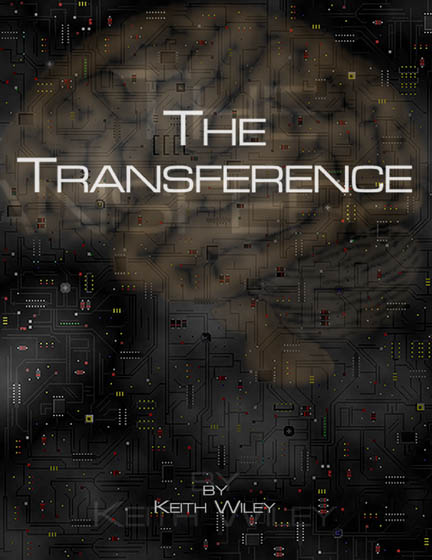Writing
The term writing, as the name of this webpage implies, is pretty general. My writing spans genres as diverse as poetry, novels, unpublished opinion essays, technical book chapters, one nonfiction book (philosophy of mind), invited and op-ed magazine articles, and of course, peer-reviewed academic research papers. As such, the locations to find my writing on this website are not very centralized. The sections-list at the top should provide a helpful index however.
Sections
Published or submitted articles, papers, books, chapters, etc.
PhD Research
Please note that I have a dedicated webpage specifically for my PhD research. All associated journal and conference papers, in addition to slides and posters, are listed at the bottom of that webpage.
Nonfiction Books
-
Book: Wiley, K. B., A Taxonomy and Metaphysics of Mind-Uploading. Humanity+ Press and Alautun Press, Sep 2014.
MIND-UPLOADING: the process of transferring one's mind from the brain to a new substrate, generally a computer. It is the stuff of science fiction, immediately recognizable in contemporary literature and cinema. However, it has also become increasingly respectable—or at least approachable—within technological, neurological, and philosophical circles. This book begins with a rich taxonomy of hypothetical procedures by which mind-uploading might be achieved, even if only in the realm of thought experiment. This is likely the most thorough collection of such procedures yet compiled and should form the basis of any reader's personal philosophy of mind and mind-uploading. It then offers one such philosophy of mind, along with an analysis and interpretation of the scenarios in the taxonomy through the lens of this philosophy. This book will be an important component of any curious reader's developing philosophy of mind and mind-uploading.
Peer Reviewed
- Journal Paper: Wiley, K. B. and Koene, R. A. The Fallacy of Favoring Gradual Replacement Mind Uploading Over Scan-and-Copy. Journal of Consciousness Studies (JoCS), Vol. 23, No. 3–4, pp212–235, Mar 2016. Pre-final draft available on arXiv.
- Journal Paper: Wiley, K. B., et al. Astronomy in the Cloud: Using MapReduce for Image Co-Addition. Publications of the Astronomical Society of the Pacific (PASP), Vol. 123, No. 901, pp366–380, Mar 2011.
- Conference Paper: Wiley, K. B., et al. Astronomical Image Processing with Hadoop. Astronomical Data Analysis Software and Systems (ADASS) XX, pp93–96, 2010.
- Conference Slides: Wiley, K. B., et al. Astronomical Image Processing with Hadoop. Astronomical Data Analysis Software and Systems (ADASS) XX, 2010.
- Conference Slides: Wiley, K. B., et al. Parallel Distributed Image Coaddition with Hadoop. Yahoo Hadoop Summit, 2010.
- Dissertation: Wiley, K. B., Druid: Representation of Interwoven Surfaces in 2½D Drawing, Ph.D. Dissertation, University of New Mexico, 2006.
- Journal Paper: Wiley, K. B., and L. R. Williams, Representation of Interwoven Surfaces in 2½D Drawing, IEEE Computer Graphics and Applications, Vol. 27, No. 4, pp70–83, 2006.
- Conference Paper: Wiley, K. B., and L. R. Williams, Representation of Interwoven Surfaces in 2½D Drawing, Proc. of CHI, Conference on Human Factors in Computing Systems, Montreal, Canada, pp65–74, 2006.
Submitted
Invited
- Chapter: Wiley, K. B., Chambers, S. Long Exposure Webcams and Image Stacking Techniques. The Art and Science of CCD Astronomy, 2nd edition. David Ratledge, ed., Ch. 4, pp45–60, 2005.
- Article: Wiley, K. B. Long Exposure Webcams and Image Stacking Techniques for the Budget-Minded Astrophotographer. Astronomy. Bakich, Michael, ed. pp94–97, Dec 2003.
- Chapter: Wiley, K. B. Pattern Evolver, An Evolutionary Algorithm that Solves the Nonintuitive Problem of Black and White Pixel Distribution to Produce Tiled Patterns that Appear Gray. The Handbook of Genetic Algorithms. Chambers, Lance D., ed. CRC Press. pp85–102, 1999.
Op-ed
- Article: The Stream of Consciousness and Personal Identity. IEET. Hughes, James, ed. Sep. 2019. (also available on IEET).
- Article: Implications of the BPF large mammal brain preservation prize. Blog article for the Brain Preservation Foundation, Mar 2018. (also available on BPF and IEET)
- Article: The Obligatory Mind Uploading Blockchain Crossover Article. IEET. Hughes, James, ed. Sep. 2017. (also available on IEET).
- Article: Implications of the BPF small mammal brain preservation prize, from the prosaic to the profound. Blog article for the Brain Preservation Foundation, Feb 2016. (also available on BPF)
- Article: Wiley, K. B. Mind Uploading and the Question of Life, the Universe, and Everything. IEET. Hughes, James, ed. Jul 2015. (also available on IEET). This is a shortened version of a submitted journal article.
- Article: Wiley, K. B. and Koene, R. A. The Fallacy of Favoring Gradual Replacement Mind Uploading Over Scan-and-Copy. IEET. Hughes, James, ed. May 2015. (also available on IEET). This is a shortened version of a submitted journal article (see above).
- Article: Wiley, K. B. 'Interstellar' Might Depict AI Slavery. Humanity+. Anissimov, Michael, ed. Nov 2014. (also available on Humanity+).
- Article: Wiley, K. B. Response to Susan Schneider's The Philosophy of 'Her'. Humanity+. Anissimov, Michael, ed. Mar 2014. (also available on Humanity+).
- Article: Wiley, K. B. Implications of Computerized Intelligence on Interstellar Travel. Humanity+. Anissimov, Michael, ed. Sep 2011. (also available on Humanity+).
Presentation Videos and Slides
- Slides: The Stream of Consciousness and Personal Identity, Jun 2020. In June 2020, I converted my 2019 paper of the same name to a slidedeck and presented it to the Carboncopies.org journal club.
- Video: Why a Whole Brain Preservation from your Preserved Brain is Probably You, Apr 2018. This is the talk that I presented at the 2018 April 29th Carboncopies workshop. The theme and title of the workshop was From Brain Preservation to Reconstruction, as a follow-up to the Brain Preservation Foundation's March announcement that its Large Mammal Brain Preservation prize had been won.
- Slides: Brain Preservation as a medical treatment for life extension: current status and future prospects, Oct 2016. Presented at Extreme Futures Technology and Forecasting (EFTF) 2016. Description of current cryonics and its serious problems, followed by the BPF's small mammal prize and consequent implications.
- Video: Voyages of the Ship of Theseus
, Sep 2016. The Ship of Theseus thought experiment is often brought up in debates about mind uploading, but is not well covered by other presentations in my opinion. So I made my own.
- Slides: Introduction to Neuromorphic Computing, With an emphasis on General Vision's consumer-affordable CM1K chip, Jun 2016. Overview of neuromorphic computing, followed by a description of my CM1K emulator and details of modeling/prediction experiments to characterize the chip's classification performance.
- Slides: Dissertation defense slides
Posters
Unpublished essays
Philosophical and Nontechnical
I have a dedicated Mind Ramblings webpage specifically for my collection of informal essays. The topics are Computer Technology and the Future, Genetic Technology, Science and Exploration, Politics, Religion, and Miscellaneous. Please surf on over to my MindRamblings webpage to see them.
Technical
Novels
I like to write fiction; I wish I had more time for it. I have been known to dabble in poetry, but most of my writing consists of sci-fi and fantasy full-length novels (and numerous false starts of course). All of the writing listed below The Transference occurred while I was still in high school and I went all the way through college without writing another word outside college work, until The Transference.
-
Contemplating Oblivion, 2024
Qualia: the quality or feeling of a conscious experience. Qualia can't be described, they must be experienced to be known. A million years in the future, physics is closed. Humanity has computerized the brain, solved death, and spread across the galaxy. The greatest challenge that remains is figuring out how a quadrillion immortal, nearly omnipotent humans might survive the eventual end of the universe.
Lysandra is a million-year-old quale-diver, a person who designs novel neural configurations in search of new conscious experiences—qualia. When she discovers a conscious state that hints at a solution to the universe-survival problem, the entire galaxy erupts with renewed excitement and hope. The final question to end all questions might be on the brink of a solution. But there are those who believe that surviving the end of the universe will destabilize the timeless cycle of infinite universes, leading to eternal oblivion, and they will stop at nothing to prevent Lysandra from completing her work.
-
Untitled, 2022 — Despite being left untitled, this book was actually written to completion. It is categorically strange, a combination of memoir-style vignettes of post-divorce parenting, traveling, and dating stories from a six-year span of my life, punctuated with scenes of my hikes around the Pacific Northwest, the latter decorated with a fictional component in which I attempt to find the perfect place to bury or spread my cat's ashes. The surreal blend of fact—with obvious necessary name-changing—and fiction probably makes the book unreadable, as readers would have no clear idea which parts are historical and which are made up (short of including an awkward disclaimer to that effect). The formal description is as follows:
A divorced dad takes his cat's ashes on multiple hikes over the course of a summer, seeking the perfect spot to lay them to rest. Along the way, he comes to terms with post-marriage life through vignettes of parenting, traveling, self-discovery, and modernized midlife dating.
The tragic twist to the plot is that over the course of the various hikes, due to minor accidents and mishaps along the way, a small amount of the ashes is steadily lost. By the time the protagonist finds the perfect place to spread his cat's ashes, he realizes the last bit has just disappeared and he has nothing left to formally bury or spread. It has occurred to me a while after coming up with this idea that it has similarities to The Old Man and the Sea, in which the fish is steadily picked apart before he can return with it to port.
Other than sending it to a few agents to see if I could get any bites, it has never been read outside my family, and probably never will (nor should).
-
The Migrators, 2009 — Written and completed in the early months of 2009. This story grew from an idea I have had for a long time: That vampires should migrate between the deep northern and southern hemispheres twice a year so as to live in perpetual darkness. I introduced a few other elements that are uncommon in other vampire mythoi, such as: Only a very small fraction of people are actually capable of turning into vampires. This alleviates — if not fully obviates — the mathematical paradox posed by exponentially asexual reproducing immortals. In addition, my mythos and associated story has very little supernaturalism. Vampires are immortal, but in a biologically rational way. They are stronger and faster, but not unbelievably so. They drink blood, but more from a desperate addiction than as a magical source of power. This story is also a heavy romance and a murder mystery...all wrapped up into one!
-
The Transference, 1998
Written and completed in the early months of 1998. The writing was better than any of my past endeavours in my opinion. The central theme of this story was mind-uploading. Namely, it was about the garage hacker who finally figures out how to successfully perform mind-uploading and the complicated events going on in his life at the time. The world I created portrayed a twenty-first century take on mind-altering drugs, i.e., the idea that instead of using chemicals to induce neurological effects, neuro-electronic computational devices are used to directly stimulate, alter, and control the neural firing patterns of the brain. There was also a thick side plot concerning sentient artificial life living in the internet. I sent this one to a few literary agents and even got a few bites back, but ultimately nothing ever came of it.
-
White Sand, 1991 — Written and completed, only my second completed novel at the time. A small group of kids get stranded on a desert island. I know, I know, Lord of the Flies. I don't want to hear it.
-
Misc, 1990-1991 — A period marked by several incomplete writing projects. Some of the attempted novels were still the same setting as my first two stories (side stories about the pasts of the particular characters). Some were completely different ideas. One was about the first manned trip to Mars, one was about the theft of the fastest space ship ever built, just various writing, nothing noteworthy.
-
Untitled, 1990? — Half of a sequel to the first novel with the same characters. Eventually abandoned.
-
Untitled, 1989-1990 — A fantasy novel (you know, wizards, dragons, knights, the lot), written when I was fourteen and fifteen. It was, admittedly, heavily influenced by The Lord of the Rings.

Short Stories
-
Eternal Being, 2023 — Some of my writing straddles the boundary between prose and poetry. I'm often not sure how to classify it. This piece is a perfect example of that ambiguity.
-
Persistence, started 2011, completed 2014 — Published in Visions of the Future, Batt, J. D. (ed.), Lifeboat Foundation (pub.), 2015. This short story proudly shares space in a book that includes Hugo and Nebula Award winners, among other distinctions. Quite the honor. The story portrays the first-person perspective of a Von Neumann probe as it arrives in its destination solar system.
Poetry
I don't have much of my poetry on my website I'm afraid. I haven't written much poetry since high school actually. The poem shown below was written much later, in graduate school.
-
What Do I Think About Lying Awake at Night?, 2014 — I am undecided whether this is a poem or an essay. Choose for yourself.
-
I Watch as You Sleep, 2000 — I composed most of this poem in my head while sitting in class one day and quickly wrote it down when I got home that evening. It was inspired by the fact that women always wonder why men like to watch them sleep. Go figure.
|







